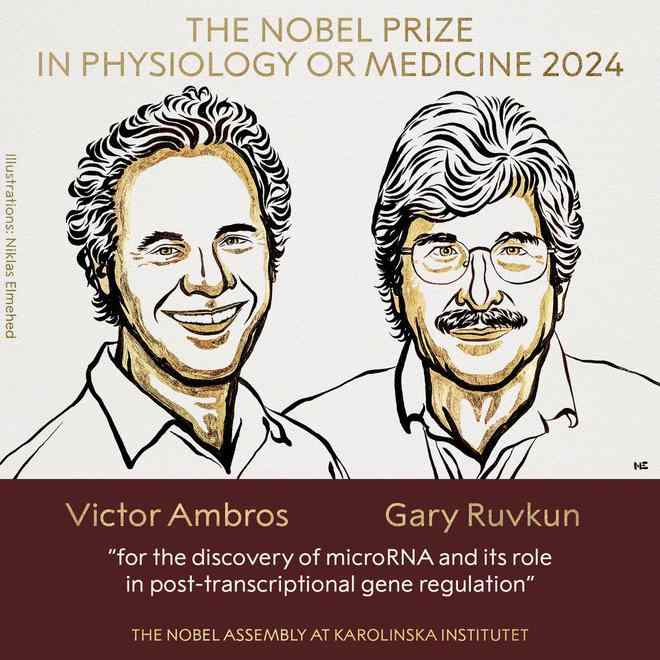
Official Award Chart for the 2024 Nobel Prize in Physiology or Medicine
On October 7, the Caroline School of Medicine in Sweden announced at local time that it had awarded the 2024 Nobel Prize in Physiology or Medicine to scientists Victor Ambros and Gary Ruvkun for their discovery of microRNAs and their role in post-transcriptional gene regulation. The two winners will share the 11 million Swedish kronor (about 7.45 million yuan) prize money equally.
MicroRNAs are a class of small RNA molecules that play a key role in gene regulation. The two scientists' discovery introduces a new principle of gene regulation, which is crucial for multicellular organisms, revealing that the human genome encodes more than a thousand types of tiny RNAs. the discovery opens up a new dimension in understanding the function of organisms and how they develop.
Victor Ambrose was born in Hanover, New Hampshire, USA, in 1953. He received his PhD from MIT in 1979, was a postdoctoral fellow at MIT from 1979 to 1985, became a principal investigator at Harvard University in 1985, was a professor at Dartmouth Medical School from 1992 to 2007, and is currently the University of Massachusetts Medical School Worcester's Silverman Professor of Natural Sciences.
Gary Ruvkun was born in Berkeley, California, in 1952, received his Ph.D. from Harvard University in 1982, was a postdoctoral fellow at the Massachusetts Institute of Technology from 1982 to 1985, became a principal investigator at Massachusetts General Hospital and Harvard Medical School in 1985, and is now a professor of genetics at Harvard Medical School.
In the late 1980s, Ambrose and Ruvkan did postdoctoral work in the laboratory of 2002 Nobel Laureate Robert Horvitz, where they became interested in how different types of cells develop.
In Horwitz's lab, they studied a relatively unassuming worm about 1 millimeter long, the Cryptobacterium showyi nematode. Despite its small size, the cryptic nematode possesses many of the specialized cell types, such as nerve cells and muscle cells, that are found in larger, more complex animals, making this nematode a useful reference for studying the development and maturation of tissues in multicellular organisms.
There are two types of RNA in organisms: those involved in coding for proteins, such as messenger RNA, which directs the synthesis of proteins; and those that do not code for proteins, known as non-coding RNA. MicroRNA is one of the non-coding RNAs, which is called microRNA because it is a short chain of only 21-23 nucleotides.
The two scientists studied two separate mutation types in nematodes: lin-4 and lin-14, which exhibit abnormal gene activation times in development. In the study, Ambrose discovered the first tiny RNA, and almost at the same time Ruvkan discovered the associated regulatory mechanism and noted that gene regulation in lin-4 and lin-14 occurs at the protein synthesis stage, not at the messenger ribonucleic acid production stage.
Sten Linnarsson, a member of the judging committee and professor at the Carolinas School of Medicine, explained in an Oct. 7 interview that genes are activated in the right cells, and that “one of the mechanisms is the transcription factors that we understood before, and the discovery of the tiny ribonucleic acids demonstrates another new regulatory mechanism that inhibits the function of messenger ribonucleic acids, which allows cells to exhibit different properties.”
Please specify source if reproduced2024 the Nobel Prize in Physiology or Medicine | SCISOON

